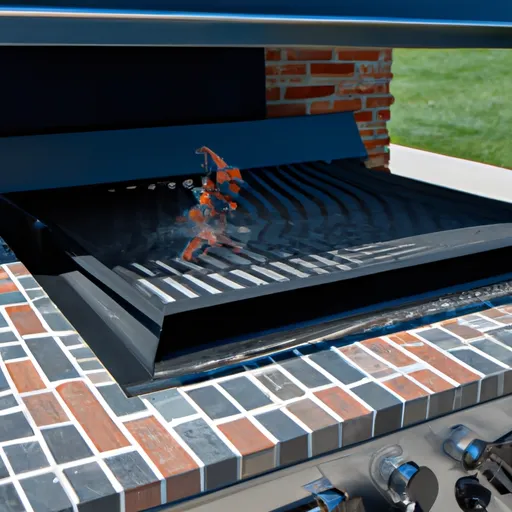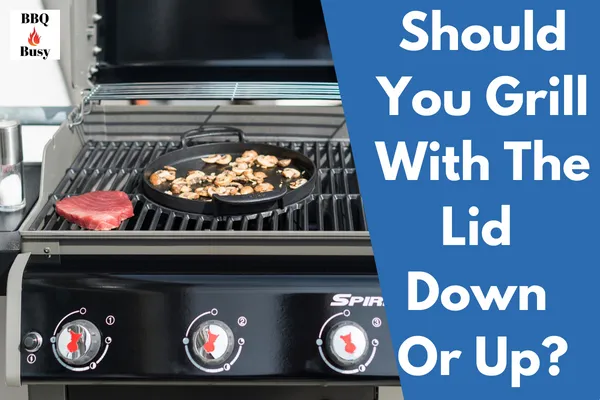
Looking to add a built-in grill to your outdoor living space? It’s important to know that not all grills are created equal when it comes to being used as a built-in option.
While some may be able to make the transition, others simply aren’t designed for the job. Before you start shopping, there are a few key factors to consider.
From size and fuel type to materials and overall design, each element plays a role in determining whether a grill is suitable for use as a built-in or not. By taking the time to understand these considerations, you’ll be better equipped to choose the right grill for your needs and ensure that it can withstand years of outdoor cooking adventures.
Factors to Consider When Choosing a Built-In Grill
Before making a decision on the perfect built-in option, it’s important to consider several factors.
First and foremost, you need to ensure that the grill is designed for built-in use. Not all grills are suitable for this purpose, and using the wrong type of grill could lead to serious safety concerns.
Additionally, you should consider the size of your outdoor kitchen space and choose a grill that fits comfortably within it. A larger grill may be more impressive, but if it takes up too much space in your outdoor kitchen, it could make cooking and entertaining challenging.
You should also think about the features you want in a grill – do you need multiple burners or a rotisserie? Do you want a side burner or an infrared searing station?
By considering these factors before purchasing a built-in grill, you can ensure that you get the perfect one for your needs.
Size Matters: Finding the Right Grill for Your Space
Finding the perfect grill size for your outdoor space can be a difficult task, but it’s important to ensure that it fits seamlessly and complements the overall aesthetic of your area.
Here are four key factors to consider when finding the right built-in grill size:
1. Measure your space: Before purchasing a grill, measure the area where you plan to install it. This will give you an idea of how much room you have to work with and help determine what size grill will fit best.
2. Consider usage: How often do you plan on using your grill? If you’re someone who grills frequently or likes to host large gatherings, then a larger grill may be necessary.
3. Think about features: Do you want additional features such as rotisserie burners or side burners? These can take up extra space and impact the size of the grill.
4. Look at aesthetics: The last thing you want is for your beautiful outdoor space to be overshadowed by an oversized or undersized built-in grill. Choose a size that complements your existing decor and blends in seamlessly with the rest of your outdoor area.
Fuel Type: Gas or Charcoal?
Deciding on gas or charcoal for fuel is like choosing between a sleek sports car and a vintage muscle car – both have their unique advantages and appeal, but ultimately it comes down to personal preference.
Gas grills are convenient and easy to use with the turn of a knob, while charcoal grills offer that smoky flavor that can’t be replicated. Some grill enthusiasts swear by using charcoal, claiming it provides better heat control and searing capabilities.
If you’re looking for convenience and speed, gas is the way to go. With no need to wait for coals to heat up or deal with ash cleanup, you can get cooking in minutes. However, if you enjoy the process of prepping your grill with briquettes, patiently waiting for them to heat up just right, then charcoal may be your choice.
Regardless of which fuel type you choose, make sure it’s compatible with your built-in grill setup before making any purchases.
Materials: Which Ones Are Best for Built-In Grills?
When it comes to building your dream outdoor kitchen, it’s important to consider the materials that will best suit your built-in grill. Here are four options to choose from:
1. Stainless Steel: This is a popular choice for built-in grills due to its durability and resistance to rust and corrosion. It also gives a sleek, modern look to your outdoor kitchen.
2. Ceramic: Ceramic grills are known for their ability to retain heat and provide even cooking temperatures. They come in a variety of colors and can add a unique touch to your outdoor space.
3. Cast Iron: Cast iron grills are durable and provide excellent heat retention. They do require seasoning, but this can add flavor to your food while protecting the surface from rust.
4. Stone: Stone is a natural choice for an outdoor kitchen as it blends seamlessly with nature. It provides great insulation and can withstand extreme temperatures, making it perfect for year-round use.
Consider these materials when choosing a built-in grill for your outdoor kitchen. Each option has its own advantages, so make sure you select the one that best suits your style and cooking needs!
Built-In Grill vs. Freestanding: Which is Right for You?
If you’re looking to take your outdoor cooking game to the next level, it’s worth considering whether a built-in or freestanding grill would be the better fit for your lifestyle and needs.
A built-in grill is a great option if you have a dedicated outdoor kitchen space and want a seamless look that blends in with your overall design. These grills are typically more expensive than freestanding models, but they offer more customization options and can increase the value of your home.
On the other hand, if you don’t have a permanent outdoor kitchen setup or want the flexibility to move your grill around, a freestanding model might be the way to go. These grills come in various sizes and styles, making them suitable for any backyard or patio space. Plus, they’re generally less expensive than built-in models and can be easily transported if you move homes.
Ultimately, choosing between a built-in or freestanding grill comes down to personal preference and what works best for your lifestyle.
Conclusion
Congratulations! You’ve now got a better understanding of the factors to consider when choosing a built-in grill.
Remember, size matters, so make sure you measure your space before selecting a grill.
Think about whether you prefer gas or charcoal as your fuel source and which materials will be best for your specific needs.
But wait, there’s more! Don’t forget to decide if a built-in or freestanding grill is right for you.
Whether you’re an outdoor cooking enthusiast or just looking for a new way to enjoy meals with family and friends, finding the perfect built-in grill can take your backyard barbecues to the next level.
So go ahead and start grilling like a pro!


